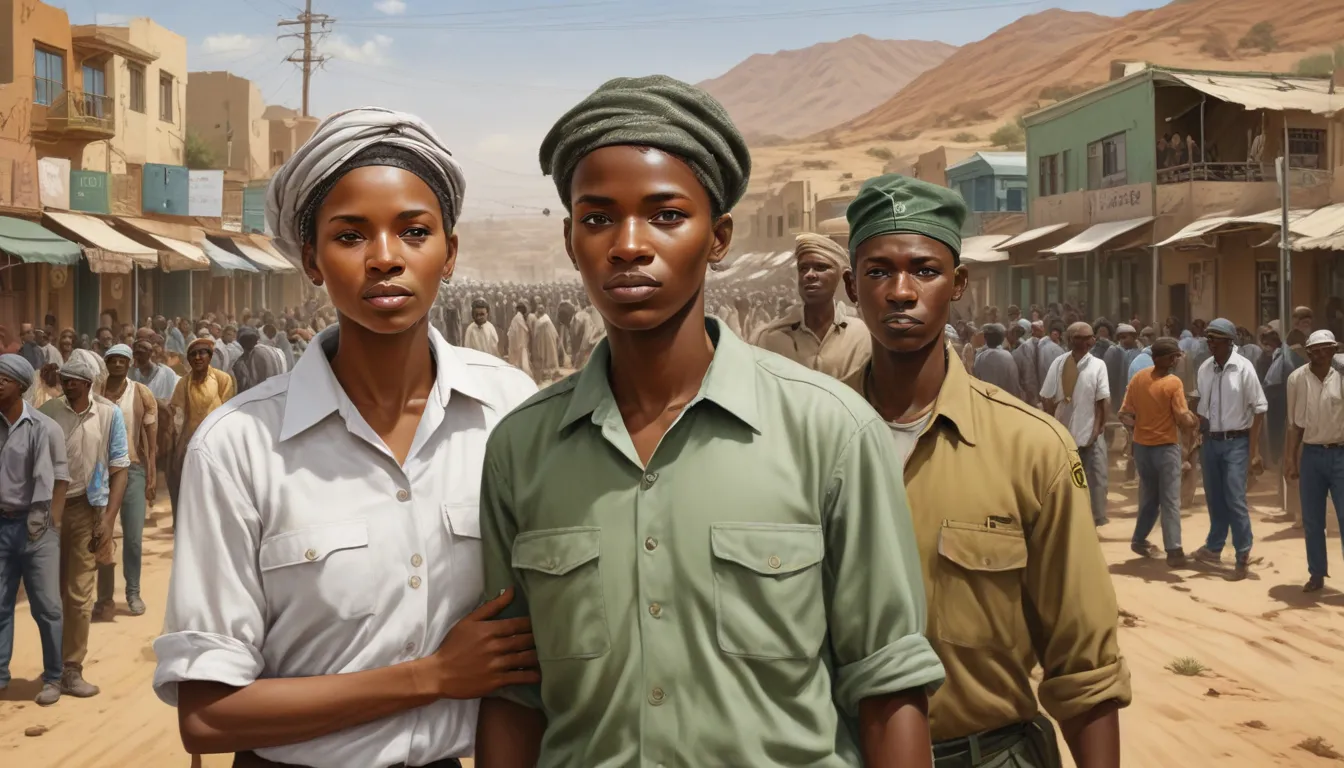The images in our articles may not match the content exactly. They are used to grab your attention, not to show the exact details in the text. The images complement the text but do not replace it.
In the annals of history, one chapter stands out for its profound impact on society: apartheid in South Africa. This policy of racial segregation and discrimination left an indelible mark on the nation, shaping its trajectory for decades. But what truly transpired during those tumultuous years, and how did South Africa emerge from the shadows of this oppressive system? In this comprehensive guide, we delve into 28 captivating facts about apartheid that illuminate its complexities, the struggle for freedom, and the heroes who stood against it. From the inception of apartheid laws to the triumphant dismantling of this discriminatory regime, these facts not only educate but also inspire. So, are you ready to embark on a journey through a pivotal period in history? Get ready for an enlightening experience that will broaden your perspective and enrich your understanding of the human spirit’s resilience in the face of adversity.
Unpacking the Essence of Apartheid: A Closer Look
At its core, apartheid was a system of institutionalized racial segregation and discrimination in South Africa that governed the nation from 1948 to the early 1990s. This policy aimed to uphold white supremacy while subduing and marginalizing the black majority and other ethnic groups within the country.
-
Meaning Behind Apartheid: The term apartheid translates to “apartness” in Afrikaans, underscoring the system’s emphasis on separating different racial groups.
-
Formalization of Apartheid: The National Party, which ascended to power in 1948, institutionalized apartheid by enshrining existing racial segregation and discriminatory practices into law.
Unveiling the Legal Framework of Apartheid
A multitude of laws were enacted to enforce apartheid, permeating every facet of society, from marriage and residence to employment and public amenities.
-
Population Registration Act: Enacted in 1950, this law mandated the classification of South Africans into distinct racial categories like white, black, coloured, and Indian.
-
Group Areas Act: Introduced in 1950, this legislation delineated designated areas where each racial group could reside and work, leading to forced relocations and the establishment of segregated townships.
-
Separate Amenities Act: Enacted in 1953, this law segregated public facilities such as beaches, buses, hospitals, schools, and even park benches based on racial distinctions.
Resilience and Resistance: Defying the Shackles of Apartheid
Despite the oppressive nature of apartheid, resistance movements sprang forth both domestically and internationally to challenge this discriminatory regime.
-
African National Congress (ANC): Formed in 1912, the ANC emerged as a prominent force in opposing apartheid, advocating for a democratic and racially inclusive South Africa.
-
Nelson Mandela: A revered figure within the ANC, Mandela was arrested in 1962 and sentenced to life imprisonment for his role in combating apartheid.
-
International Pressure: During the 1980s, global pressure mounted on South Africa, with nations imposing economic sanctions and spearheading divestment campaigns to dismantle apartheid.
Demise of Apartheid and Its Enduring Legacy
The foundations of apartheid began to crumble in the late 1980s and early 1990s, ushering in significant political transformations and heralding a new era for South Africa.
-
F.W. de Klerk’s Initiatives: In 1990, President F.W. de Klerk initiated the dismantling of apartheid laws and released Nelson Mandela from captivity after 27 years.
-
Dawn of Democracy: The inaugural democratic elections took place in 1994, culminating in Mandela’s historic election as South Africa’s first black president.
-
Truth and Reconciliation Commission: Established in 1995, this commission sought to foster healing within the nation and address the atrocities committed during the apartheid era.
Cultural and Social Ripple Effects of Apartheid
Apartheid reverberated through the cultural and social landscape of South Africa, leaving an indelible imprint on various spheres such as music, literature, and sports.
-
Musical Resistance: Music served as a powerful tool in the anti-apartheid movement, with artists utilizing their craft to protest against racial injustices both locally and globally.
-
Literary Expression: Literature and poetry emerged as poignant mediums for dissent, with authors like Nadine Gordimer and Alan Paton shining a spotlight on the struggles of non-white populations under apartheid.
-
Sports Realm: Apartheid’s influence extended to sports, particularly rugby, leading to international bans and boycotts as a form of protest against South Africa’s discriminatory practices.
Educational Implications of Apartheid
One of the areas profoundly impacted by apartheid was education, with systematic disparities perpetuated through segregated schooling systems.
-
Bantu Education Act: Enforced in 1953, this act severely restricted the educational opportunities available to black South Africans, aiming to constrain them to a life of labor and servitude.
-
Segregation in Universities: Higher education institutions were segregated, greatly limiting the access of non-white individuals to quality education and perpetuating educational inequalities.
Economic Disparities Wrought by Apartheid
Beyond segregating communities, apartheid engendered vast economic chasms that continue to persist in contemporary South Africa.
-
Labor Restrictions: Black South Africans were confined to menial jobs with meager remuneration, often necessitating the carrying of passbooks to work in white-allocated areas.
-
Homelands System: The system of homelands displaced millions of black South Africans to rural regions, exacerbating poverty and constricting economic opportunities.
-
Lingering Economic Divides: Despite the demise of apartheid, enduring economic disparities between racial groups underscore the enduring legacies of this discriminatory regime.
Apartheid in a Global Context
The apartheid regime in South Africa was not an isolated phenomenon but rather part of a broader global struggle against racial discrimination.
-
International Opposition: The international community played a pivotal role in denouncing apartheid, with the United Nations imposing an arms embargo on South Africa in 1977.
-
Activist Mobilization: Activists worldwide, including in the United States and the United Kingdom, orchestrated boycotts and protests, bolstering the global movement to dismantle apartheid.
-
Triumph of Solidarity: The downfall of apartheid is hailed as a testament to international solidarity and the collective efforts of the global human rights movement against systemic discrimination.
Pondering Apartheid’s Enduring Legacy
The reverberations of apartheid continue to reverberate through South Africa’s social fabric, politics, and international relations, posing ongoing challenges and opportunities for growth.
-
Reconciliation Efforts: South Africa’s journey towards reconciliation involves grappling with deep-seated economic and social disparities entrenched during apartheid.
-
Model for Conflict Resolution: The nation’s transition from apartheid to democracy serves as a model for resolving conflicts and nurturing peace, inspiring nations beset by similar divisions.
-
Resilience in Adversity: Apartheid’s narrative and eventual dismantling epitomize the resilience of the human spirit in confronting systemic oppression and injustice.
-
Educational Imperative: Educating future generations about apartheid is imperative to safeguard the tenets of human rights and sensitizing individuals to the perils of racial discrimination.
-
Remembrance and Commemoration: Memorials and museums like the Apartheid Museum in Johannesburg play a pivotal role in preserving the history and lessons of apartheid for posterity.
-
Universal Relevance of Apartheid’s Lessons: The global community continues to draw insights from apartheid, applying its lessons to contemporary struggles against racism and inequality.
Reflecting on Apartheid’s Enduring Influence
Apartheid stands as a harrowing chapter in South Africa’s narrative, leaving an indelible mark on its populace and resonating with communities worldwide. Beyond mere historical significance, apartheid symbolizes a clarion call to embrace equality, empathy, and solidarity within our communities. The dismantling of apartheid and the transition to democracy in 1994 represent not just a triumph for South Africa but a beacon of hope for oppressed populations globally. Let us heed the lessons of history and forge a path marked by inclusivity, compassion, and unity. Remember, the past’s teachings are invaluable guides to forging a brighter, more equitable future.
FAQ
Q: What was apartheid?
A: Apartheid was a system of institutionalized racial segregation and discrimination in South Africa from 1948 to the early 1990s.
Q: How did apartheid impact daily life in South Africa?
A: Apartheid profoundly affected daily life by imposing severe restrictions on non-white individuals regarding residence, employment, education, and mobility.
Q: When did apartheid officially end?
A: Apartheid began to unravel in the late 1980s and officially ended in the early 1990s with the release of Nelson Mandela and the advent of multi-racial democratic elections in 1994.
Q: Who were key figures in the fight against apartheid?
A: Nelson Mandela, Desmond Tutu, and organizations like the African National Congress (ANC) were pivotal figures challenging apartheid.
Q: What were the “homelands” in the context of apartheid?
A: “Homelands” were designated territories for black South Africans under apartheid, intended as self-governing entities but largely economically dependent on South Africa.
Q: How did the international community respond to apartheid?
A: The international community condemned apartheid, imposing economic sanctions and cultural boycotts to pressure South Africa to dismantle the discriminatory regime.
Q: What is the legacy of apartheid in present-day South Africa?
A: South Africa grapples with enduring economic disparities and social divisions stemming from apartheid, necessitating ongoing efforts to foster reconciliation and unity.
Feedback Request
Your feedback helps us uphold our commitment to delivering accurate and engaging content, fostering a community of shared knowledge and learning. Each fact shared is a testament to our users’ diverse insights and perspectives. Our dedicated editors diligently review each submission to ensure credibility and authenticity, ensuring that the facts we present are both captivating and reliable. Trust in our dedication to excellence and genuine information as you embark on your journey of exploration and enlightenment.






